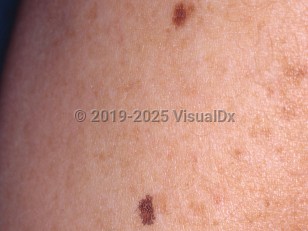Clinically, asymptomatic, well-circumscribed, symmetric, homogeneous, light brown to black macules are seen. They are usually smaller than 5 mm in size. They are distributed anywhere on the trunk, extremities, genitals, and mucous membranes. Lentigines found on mucous membranes can appear irregular with increased size, irregular borders, and heterogeneous pigmentation. Lentigo simplex may evolve into junctional nevi but are not thought to evolve into melanoma. They differ from solar lentigines in that they appear earlier in life on non-sun-exposed skin. They occasionally form in cutaneous scars and may be associated with psoralen / ultraviolet light therapy.
Lentigo simplex may occur as a single or as multiple lesions. Occasionally, multiple lentigines are associated with rare genetic disorders. These include the following:
- LEOPARD syndrome – lentigines, ECG changes, ocular hypertelorism, pulmonary stenosis, abnormal genitalia, growth retardation, and deafness
- Carney complex – lentigines, atrial myxoma, mucocutaneous myxoma, and nevi
- Peutz-Jeghers syndrome – lentigines (perioral and oral), multiple gastrointestinal polyps, and visceral tumors (pancreas, ovary, testes)
- Xeroderma pigmentosum – lentigines on sun-exposed skin and multiple skin cancers
- Cronkhite-Canada syndrome – lentigines (buccal mucosa, face, palmoplantar), alopecia, nail dystrophy, and intestinal polyps



 Patient Information for
Patient Information for 
